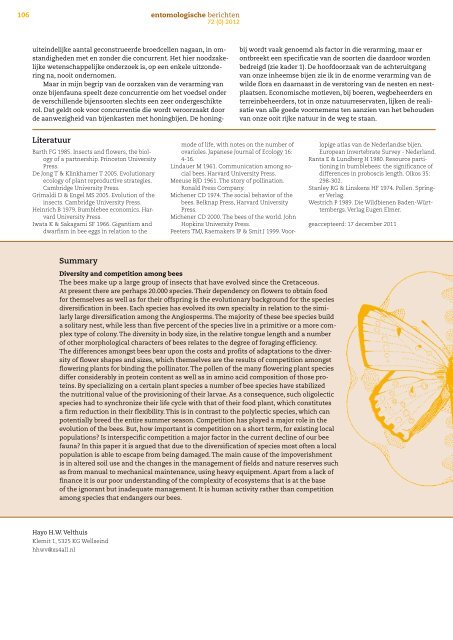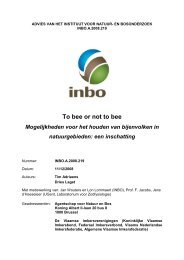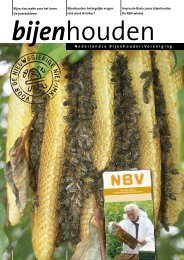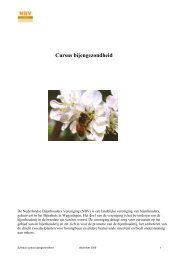Diversiteit en concurrentie bij bijen
Diversiteit en concurrentie bij bijen
Diversiteit en concurrentie bij bijen
You also want an ePaper? Increase the reach of your titles
YUMPU automatically turns print PDFs into web optimized ePapers that Google loves.
106 <strong>en</strong>tomologische bericht<strong>en</strong><br />
72 (0) 2012<br />
uiteindelijke aantal geconstrueerde broedcell<strong>en</strong> nagaan, in omstandighed<strong>en</strong><br />
met <strong>en</strong> zonder die concurr<strong>en</strong>t. Het hier noodzakelijke<br />
wet<strong>en</strong>schappelijke onderzoek is, op e<strong>en</strong> <strong>en</strong>kele uitzondering<br />
na, nooit ondernom<strong>en</strong>.<br />
Maar in mijn begrip van de oorzak<strong>en</strong> van de verarming van<br />
onze <strong>bij</strong><strong>en</strong>fauna speelt deze concurr<strong>en</strong>tie om het voedsel onder<br />
de verschill<strong>en</strong>de <strong>bij</strong><strong>en</strong>soort<strong>en</strong> slechts e<strong>en</strong> zeer ondergeschikte<br />
rol. Dat geldt ook voor concurr<strong>en</strong>tie die wordt veroorzaakt door<br />
de aanwezigheid van <strong>bij</strong><strong>en</strong>kast<strong>en</strong> met honing<strong>bij</strong><strong>en</strong>. De honing-<br />
Literatuur<br />
Barth FG 1985. Insects and flowers, the biology<br />
of a partnership. Princeton University<br />
Press.<br />
De Jong T & Klinkhamer T 2005. Evolutionary<br />
ecology of plant reproductive strategies.<br />
Cambridge University Press.<br />
Grimaldi D & Engel MS 2005. Evolution of the<br />
insects. Cambridge University Press.<br />
Heinrich B 1979. Bumblebee economics. Harvard<br />
University Press.<br />
Iwata K & Sakagami SF 1966. Gigantism and<br />
dwarfism in bee eggs in relation to the<br />
Summary<br />
<strong>bij</strong> wordt vaak g<strong>en</strong>oemd als factor in die verarming, maar er<br />
ontbreekt e<strong>en</strong> specificatie van de soort<strong>en</strong> die daardoor word<strong>en</strong><br />
bedreigd (zie kader 1). De hoofdoorzaak van de achteruitgang<br />
van onze inheemse <strong>bij</strong><strong>en</strong> zie ik in de <strong>en</strong>orme verarming van de<br />
wilde flora <strong>en</strong> daarnaast in de verstoring van de nest<strong>en</strong> <strong>en</strong> nestplaats<strong>en</strong>.<br />
Economische motiev<strong>en</strong>, <strong>bij</strong> boer<strong>en</strong>, wegbeheerders <strong>en</strong><br />
terreinbeheerders, tot in onze natuurreservat<strong>en</strong>, lijk<strong>en</strong> de realisatie<br />
van alle goede voornem<strong>en</strong>s t<strong>en</strong> aanzi<strong>en</strong> van het behoud<strong>en</strong><br />
van onze ooit rijke natuur in de weg te staan.<br />
Diversity and competition among bees<br />
The bees make up a large group of insects that have evolved since the Cretaceous.<br />
At pres<strong>en</strong>t there are perhaps 20.000 species. Their dep<strong>en</strong>d<strong>en</strong>cy on flowers to obtain food<br />
for themselves as well as for their offspring is the evolutionary background for the species<br />
diversification in bees. Each species has evolved its own specialty in relation to the similarly<br />
large diversification among the Angiosperms. The majority of these bee species build<br />
a solitary nest, while less than five perc<strong>en</strong>t of the species live in a primitive or a more complex<br />
type of colony. The diversity in body size, in the relative tongue l<strong>en</strong>gth and a number<br />
of other morphological characters of bees relates to the degree of foraging effici<strong>en</strong>cy.<br />
The differ<strong>en</strong>ces amongst bees bear upon the costs and profits of adaptations to the diversity<br />
of flower shapes and sizes, which themselves are the results of competition amongst<br />
flowering plants for binding the pollinator. The poll<strong>en</strong> of the many flowering plant species<br />
differ considerably in protein cont<strong>en</strong>t as well as in amino acid composition of those proteins.<br />
By specializing on a certain plant species a number of bee species have stabilized<br />
the nutritional value of the provisioning of their larvae. As a consequ<strong>en</strong>ce, such oligolectic<br />
species had to synchronize their life cycle with that of their food plant, which constitutes<br />
a firm reduction in their flexibility. This is in contrast to the polylectic species, which can<br />
pot<strong>en</strong>tially breed the <strong>en</strong>tire summer season. Competition has played a major role in the<br />
evolution of the bees. But, how important is competition on a short term, for existing local<br />
populations? Is interspecific competition a major factor in the curr<strong>en</strong>t decline of our bee<br />
fauna? In this paper it is argued that due to the diversification of species most oft<strong>en</strong> a local<br />
population is able to escape from being damaged. The main cause of the impoverishm<strong>en</strong>t<br />
is in altered soil use and the changes in the managem<strong>en</strong>t of fields and nature reserves such<br />
as from manual to mechanical maint<strong>en</strong>ance, using heavy equipm<strong>en</strong>t. Apart from a lack of<br />
finance it is our poor understanding of the complexity of ecosystems that is at the base<br />
of the ignorant but inadequate managem<strong>en</strong>t. It is human activity rather than competition<br />
among species that <strong>en</strong>dangers our bees.<br />
Hayo H.W. Velthuis<br />
Klemit 1, 5325 KG Wellseind<br />
hhwv@xs4all.nl<br />
mode of life, with notes on the number of<br />
ovarioles. Japanese Journal of Ecology 16:<br />
4-16.<br />
Lindauer M 1961. Communication among social<br />
bees. Harvard University Press.<br />
Meeuse BJD 1961. The story of pollination.<br />
Ronald Press Company.<br />
Mich<strong>en</strong>er CD 1974. The social behavior of the<br />
bees. Belknap Press, Harvard University<br />
Press.<br />
Mich<strong>en</strong>er CD 2000. The bees of the world. John<br />
Hopkins University Press.<br />
Peeters TMJ, Raemakers IP & Smit J 1999. Voor-<br />
lopige atlas van de Nederlandse <strong>bij</strong><strong>en</strong>.<br />
European Invertebrate Survey - Nederland.<br />
Ranta E & Lundberg H 1980. Resource partitioning<br />
in bumblebees: the significance of<br />
differ<strong>en</strong>ces in proboscis l<strong>en</strong>gth. Oikos 35:<br />
298-302.<br />
Stanley RG & Linsk<strong>en</strong>s HF 1974. Poll<strong>en</strong>. Springer<br />
Verlag.<br />
Westrich P 1989. Die Wildbi<strong>en</strong><strong>en</strong> Bad<strong>en</strong>-Württembergs.<br />
Verlag Eug<strong>en</strong> Elmer.<br />
geaccepteerd: 17 december 2011








